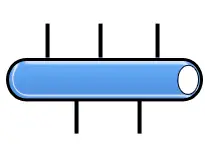Network Infrastructure Devices and Icons used in network diagrams
Network Infrastructure devices are the physical components used to build the computer network. Depending on the size of the enterprise network, different models of different capacity and quantity of network infrastructure devices are used in the network.
It is necessary to understand and perceive below network device icons, because network topology diagrams use these icons to represent network devices. These icons were originally designed by Cisco Systems, but accepted globally as standard network topology device icons today.
Please note that below list is not the complete list of network topology diagram icons. Below devices and their icons are only the important icons used in network topology diagrams. Please click following link if you want to download complete network device icons used in network topology diagrams from Cisco website.
Following table lists important devices in a computer network. If you are a beginner, some devices may not be familiar. We will discuss about those unfamiliar devices in future lessons.
Device
|
Icon |
|---|---|
| Hub |  |
| Modem |  |
| Cable Modem |  |
| Fax |  |
| Bridge |  |
| Wireless Bridge |  |
| Layer 2 Switch |  |
| Voice Switch |  |
| Multi-layer Switch |  |
| Layer 3 Switch |  |
| Router |  |
| Router with Firewall |  |
| Netflow Router |  |
| Storage Router |  |
| Wireless Routers |  |
| Voice Router |  |
| PC |  |
| PC Software |  |
| Workstation |  |
| Laptop |  |
| Directory Server |  |
| File Server |  |
| Web Server |  |
| Web Browser |  |
| Cellular Phone |  |
| Phone |  |
| IP Phone |  |
| Tower Server |  |
| Firewall (General) |  |
| Cisco IOS Firewall |  |
| Cisco PIX Firewall |  |
| Cisco ASA Firewall |  |
| Cisco Secure ACS |  |
| Cisco ISE |  |
| Ethernet Network Segment |  |
| WAN Link |  |